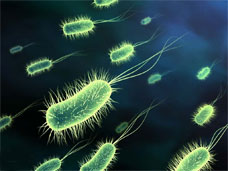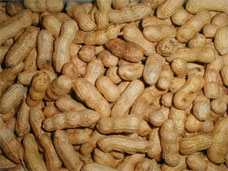|
What are food borne illnesses?
Food borne illnesses are caused by eating food or drinking
beverages contaminated with bacteria, parasites, or viruses.
Harmful chemicals can also cause food borne illnesses if they have
contaminated food during harvesting or processing. Food borne
illnesses can cause symptoms that range from an upset stomach to
more serious symptoms, including diarrhea, fever, vomiting,
abdominal cramps, and dehydration. Most food borne infections are
undiagnosed and unreported, though the Centers for Disease Control
and Prevention estimates that every year about 76 million people
in the United States become ill from pathogens, or disease-causing
substances, in food. Of these people, about 5,000 die.
What are the causes of food borne
illnesses?
Harmful bacteria are the most common cause of food borne illnesses.
Some bacteria may be present on foods when you purchase them. Raw
foods are the most common source of food borne illnesses because
they are not sterile; examples include raw meat and poultry that
may have become contaminated during slaughter. Seafood may become
contaminated during harvest or through processing. One in 10,000
eggs may be contaminated with Salmonella inside the egg shell.
Produce such as spinach, lettuce, tomatoes, sprouts, and melons
can become contaminated with Salmonella, Shigelloses, or Escherichia
coli (E. coli) O157:H7. Contamination can occur during growing,
harvesting, processing, storing, shipping, or final preparation.
Sources of produce contamination are varied as these foods are
grown in soil and can become contaminated during growth or through
processing and distribution. Contamination may also occur during
food preparation in a restaurant or a home kitchen. The most
common form of contamination from handled foods is the calcivirus,
also called the Norwalk-like virus.
When food is cooked and left out for more than 2 hours at room
temperature, bacteria can multiply quickly. Most bacteria grow
undetected because they don’t produce a bad odor or change the
color or texture of the food. Freezing food slows or stops
bacteria’s growth but does not destroy the bacteria. The microbes
can become reactivated when the food is thawed. Refrigeration also
can slow the growth of some bacteria. Thorough cooking is needed
to destroy the bacteria.
What are the symptoms of food borne illnesses?
In most cases of food borne illnesses, symptoms resemble intestinal
flu and may last a few hours or even several days. Symptoms can
range from mild to serious and include
* abdominal cramps
* nausea
* vomiting
* diarrhea, which is sometimes bloody
* fever
* dehydration
What are the risk factors of food borne illnesses?
Some people are at greater risk for bacterial infections because
of their age or an unhealthy immune system. Young children,
pregnant women and their fetuses, and older adults are at greatest
risk.
What are the complications of foodborne illnesses?
Some micro-organisms, such as Listeria monocytogenes and
Clostridium botulinum, cause far more serious symptoms than
vomiting and diarrhea. They can cause spontaneous abortion or
death.
In some people, especially children, hemolytic uremic syndrome (HUS)
can result from infection by a particular strain of bacteria, E.
coli O157:H7, and can lead to kidney failure and death. HUS is a
rare disorder that affects primarily children between the ages of
1 and 10 years and is the leading cause of acute renal failure in
previously healthy children. A child may become infected after
consuming contaminated food or beverages, such as meat, especially
undercooked ground beef; unpasteurized juices; contaminated water;
or through contact with an infected person.
The most common symptoms of HUS infection are vomiting, abdominal
pain, and diarrhea, which may be bloody. In 5 to 10 percent of
cases, HUS develops about 5 to 10 days after the onset of illness.
This disease may last from 1 to 15 days and is fatal in 3 to 5
percent of cases. Other symptoms of HUS include fever, lethargy or
sluggishness, irritability, and paleness or pallor. In about half
the cases, the disease progresses until it causes acute renal
failure, which means the kidneys are unable to remove waste
products from the blood and excrete them into the urine. A
decrease in circulating red blood cells and blood platelets and
reduced blood flow to organs may lead to multiple organ failure.
Seizures, heart failure, inflammation of the pancreas, and
diabetes can also result. However, most children recover
completely.
See a doctor right away if you or your child has any of the
following symptoms with diarrhea:
* High fever—temperature over 101.5°, measured orally
* Blood in the stools
* Diarrhea that lasts more than 3 days
* Prolonged vomiting that prevents keeping liquid down and can
lead to dehydration
* Signs of severe dehydration, such as dry mouth, sticky saliva,
decreased urination, dizziness, fatigue, sunken eyes, low blood
pressure, or increased heart rate and breathing rate
* Signs of shock, such as weak or rapid pulse or shallow breathing
* Confusion or difficulty reasoning
How are foodborne illnesses diagnosed?
Your doctor may be able to diagnose foodborne illnesses from a
list of what you’ve eaten recently and from results of appropriate
laboratory tests. Diagnostic tests for foodborne illnesses should
include examination of the feces. A sample of the suspected food,
if available, can also be tested for bacterial toxins, viruses,
and parasites.
How are foodborne illnesses treated?
Most cases of foodborne illnesses are mild and can be treated by
increasing fluid intake, either orally or intravenously, to
replace lost fluids and electrolytes. People who experience
gastrointestinal or neurologic symptoms should seek medical
attention.
In the most severe situations, such as HUS, hospitalization may be
needed to receive supportive nutritional and medical therapy.
Maintaining adequate fluid and electrolyte balance and controlling
blood pressure are important. Doctors will try to minimize the
impact of reduced kidney function. Dialysis may be needed until
the kidneys can function normally. Blood transfusions also may be
needed.
How are foodborne illnesses prevented?
Most cases of foodborne illnesses can be prevented through proper
cooking or processing of food, which kills bacteria. In addition,
because bacteria multiply rapidly between 40°F and 140°F, food
must be kept out of this temperature range.
Follow these tips to prevent harmful bacteria from growing in
food:
Refrigerate foods promptly. If prepared food stands at room
temperature for more than 2 hours, it may not be safe to eat. Set
your refrigerator at 40°F or lower and your freezer at 0°F.
*
Cook food to the appropriate internal temperature—145°F for
roasts, steaks, and chops of beef, veal, and lamb; 160°F for pork,
ground veal, and ground beef; 165°F for ground poultry; and 180°F
for whole poultry. Use a meat thermometer to be sure. Foods are
properly cooked only when they are heated long enough and at a
high enough temperature to kill the harmful bacteria that cause
illnesses.
*
Prevent cross-contamination. Bacteria can spread from one food
product to another throughout the kitchen and can get onto cutting
boards, knives, sponges, and countertops. Keep raw meat, poultry,
seafood, and their juices away from all ready-to-eat foods.
*
Handle food properly. Always wash your hands for at least 20
seconds with warm, soapy water before and after handling raw meat,
poultry, fish, shellfish, produce, or eggs. Wash your hands after
using the bathroom, changing diapers, or touching animals.
*
Wash utensils and surfaces before and after use with hot, soapy
water. Better still, sanitize them with diluted bleach—1 teaspoon
of bleach to 1 quart of hot water.
*
Wash sponges and dish towels weekly in hot water in the washing
machine.
*
Keep cold food cold and hot food hot.
*
Maintain hot cooked food at 140°F or higher.
*
Reheat cooked food to at least 165°F.
*
Refrigerate or freeze perishables, produce, prepared food, and
leftovers within 2 hours.
*
Never defrost food on the kitchen counter. Use the refrigerator,
cold running water, or the microwave oven.
*
Never let food marinate at room temperature—refrigerate it.
*
Divide large amounts of leftovers into small, shallow containers
for quick cooling in the refrigerator.
*
Remove the stuffing from poultry and other meats immediately and
refrigerate it in a separate container.
*
Wash all unpackaged fruits and vegetables, and those packaged and
not marked “pre-washed,” under running water just before eating,
cutting, or cooking. Scrub firm produce such as melons and
cucumbers with a clean produce brush. Dry all produce with a paper
towel to further reduce any possible bacteria.
*
Do not pack the refrigerator. Cool air must circulate to keep food
safe.
For more information about prevention of foodborne illnesses, the
U.S. Department of Agriculture provides a fact sheet on safe food
handling.
What is food irradiation?
Food irradiation is the treatment of food with high energy such as
gamma rays, electron beams, or x rays as a means of cold
pasteurization, which destroys living bacteria to control
foodborne illnesses. The United States relies exclusively on the
use of gamma rays, which are similar to ultraviolet light and
microwaves and pass through food leaving no residue. Food
irradiation is approved for wheat, potatoes, spices, seasonings,
pork, poultry, red meats, whole fresh fruits, and dry or
dehydrated products. Although irradiation destroys many bacteria,
it does not sterilize food. Even if you’re using food that has
been irradiated by the manufacturer, you must continue to take
precautions against foodborne illnesses—through proper
refrigeration and handling—to safeguard against any surviving
organisms. If you are traveling with food, make sure perishable
items such as meats are wrapped to prevent leakage. Be sure to
fill the cooler with plenty of ice and store it in the car, not
the trunk. If any food seems warmer than 40°F, throw it out.
Links to Other Disorders Related to Foodborne Illnesses?
Scientists suspect that foodborne pathogens are linked to chronic
disorders and can even cause permanent tissue or organ
destruction. Research suggests that when some people are infected
by foodborne pathogens, the activation of their immune system can
trigger an inappropriate autoimmune response, which means the
immune system attacks the body’s own cells. In some people, an
autoimmune response leads to a chronic health condition. Chronic
disorders that may be triggered by foodborne pathogens are
* arthritis
* inflammatory bowel disease
* kidney failure
* Guillain-Barré syndrome
* autoimmune disorders
Further research is needed to explain the link between these
disorders and foodborne illnesses.
Common Sources of Foodborne Illness?
Sources of illness: Raw and undercooked meat and poultry
Symptoms: Abdominal pain, diarrhea, nausea, and vomiting
Bacteria: Campylobacter jejuni, E. coli O157:H7, L. monocytogenes,
Salmonella
Sources of illness: Raw foods; unpasteurized milk and dairy
products, such as soft cheeses
Symptoms: Nausea, vomiting, fever, abdominal cramps, and diarrhea
Bacteria: L. monocytogenes, Salmonella, Shigella, Staphylococcus
aureus, C. jejuni
Sources of illness: Raw and undercooked eggs. Raw eggs are often
used in foods such as homemade hollandaise sauce, Caesar and other
salad dressings, tiramisu, homemade ice cream, homemade
mayonnaise, cookie dough, and frostings.
Symptoms: Nausea, vomiting, fever, abdominal cramps, and diarrhea
Bacterium: Salmonella enteriditis
Sources of illness: Raw and undercooked shellfish
Symptoms: Chills, fever, and collapse
Bacteria: Vibrio vulnificus, Vibrio parahaemolyticus
Sources of illness: Improperly canned goods; smoked or salted fish
Symptoms: Double vision, inability to swallow, difficulty
speaking, and inability to breathe. Seek medical help right away
if you experience any of these symptoms.
Bacterium: C. botulinum
Sources of illness: Fresh or minimally processed produce;
contaminated water
Symptoms: Bloody diarrhea, nausea, and vomiting
Bacteria: E. coli O157:H7, L. monocytogenes, Salmonella, Shigella,
Yersinia enterocolitica, viruses, and parasites
Points to Remember
Foodborne illnesses result from eating food or drinking beverages
that are contaminated with bacteria, viruses, or parasites.
People at greater risk for foodborne illnesses include young
children, pregnant women and their fetuses, older adults, and
people with lowered immunity.
Symptoms usually resemble intestinal flu. See a doctor immediately
if you have more serious problems or do not seem to be improving
as expected.
Treatment may range from replacement of lost fluids and
electrolytes for mild cases of foodborne illnesses to
hospitalization for severe conditions such as HUS.
You can prevent foodborne illnesses by taking the following
precautions:
*
Wash your hands with warm, soapy water before and after preparing
food and after using the bathroom or changing diapers.
*
Keep raw meat, poultry, seafood, and their juices away from
ready-to-eat foods.
*
Cook foods properly and at a high enough temperature to kill
harmful bacteria.
*
Refrigerate foods within 2 hours or less after cooking because
cold temperatures will help keep harmful bacteria from growing and
multiplying.
Clean surfaces well before and after using them to prepare food.
|







